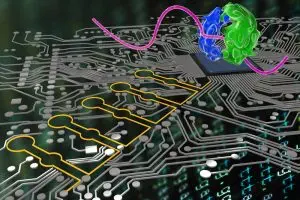
Novel RNA nano-devices in living cells can sense and analyze multiple complex signals for future synthetic diagnostics and therapeutics
The frontier of biology, DNA and computation is developing at an accelerating rate – the future of computation is deeply entangled with the mind-machine interface and even integration – the boundaries between technology biology are blurring.
“We demonstrate that an RNA molecule can be engineered into a programmable and logically acting “Ribocomputing Device,” said Wyss Institute Core Faculty member Peng Yin, Ph.D., who led the study and is also Professor of Systems Biology at Harvard Medical School. “This breakthrough at the interface of nanotechnology and synthetic biology will enable us to design more reliable synthetic biological circuits that are much more conscious of the influences in their environment relevant to specific goals.”
Synthetic biologists are converting microbial cells into living devices that are able to perform useful tasks ranging from the production of drugs, fine chemicals and biofuels to detecting disease-causing agents and releasing therapeutic molecules inside the body. To accomplish this, they fit cells with artificial molecular machinery that can sense stimuli such as toxins in the environment, metabolite levels or inflammatory signals. Much like electronic circuits, these synthetic biological circuits can process information and make logic-guided decisions. Unlike their electronic counterparts, however, biological circuits must be fabricated from the molecular components that cells can produce, and they must operate in the crowded and ever-changing environment within each cell.
So far, synthetic biological circuits can only sense a handful of signals, giving them an incomplete picture of conditions in the host cell. They are also built out of several moving parts in the form of different types of molecules, such as DNAs, RNAs, and proteins, that must find, bind and work together to sense and process signals. Identifying molecules that cooperate well with one another is difficult and makes development of new biological circuits a time-consuming and often unpredictable process.
As reported in Nature, a team at Harvard’s Wyss Institute for Biologically Inspired Engineering is now presenting an all-in-one solution that imbues a molecule of ‘ribo’ nucleic acid or RNA with the capacity to sense multiple signals and make logical decisions to control protein production with high precision. The study’s approach resulted in a genetically encodable RNA nano-device that can perform an unprecedented 12-input logic operation to accurately regulate the expression of a fluorescent reporter protein in E. coli bacteria only when encountering a complex, user-prescribed profile of intra-cellular stimuli. Such programmable nano-devices may allow researchers to construct more sophisticated synthetic biological circuits, enabling them to analyze complex cellular environments efficiently and to respond accurately.
Leave a Reply